Posted March 29, 2019, 3:40 pm CDT
 Image from Shutterstock.
Image from Shutterstock.
Affordable Internet Marketing Services is our specialty and we employ a holistic approach to achieve and maintain first page rankings for your online business within the major search engines. We do have one goal in mind…to generate more revenue for your business.
Posted March 29, 2019, 3:40 pm CDT
 Image from Shutterstock.
Image from Shutterstock.

Posted March 29, 2019, 11:38 am CDT
A federal judge said Thursday the Trump administration had tried to do “an end-run” around the Affordable Care Act when it expanded the availability of “association health plans” with fewer health protections and lower costs. U.S. District Judge John Bates of Washington, D.C., said the Department of Labor rule exceeded the statutory authority delegated in ERISA, the Employee Retirement Income Security Act, and scrapped its “careful statutory scheme.” The Washington Post, the New York Times and Politico have coverage of the March 28 opinion; a press release is here. The rule expands the kind of employers who can band together in association health plans to avoid ACA rules that require coverage for such things as mental health services and prescription drugs. Bates said the administration rule had stretched the definition of “employer” too far by including people without any employees and allowing associations of disparate employers linked only by geographic proximity. He struck down both provisions and sent the rule back to the Labor Department for an analysis of how other provisions are affected. The suit challenging the rule was filed by 11 states and Washington, D.C. Bates ruled as the Department of Justice filed notice this week that it will argue that the entire ACA should be struck down. The position differs from that taken by DOJ attorneys under then-Attorney General Jeff Sessions. They had argued that only parts of the law were unconstitutional after Congress effectively repealed its tax penalty in 2017 for people without insurance. The lawsuit is New York v. U.S. Department of Labor.Posted March 29, 2019, 12:37 pm CDT

 In honor of search engine algorithm pioneer Professor Karen Spärck Jones, let’s take a closer look at her crowning achievement: Inverse Document Frequency (idf). It still has significant impact today.
In honor of search engine algorithm pioneer Professor Karen Spärck Jones, let’s take a closer look at her crowning achievement: Inverse Document Frequency (idf). It still has significant impact today.
Idf and its variants underpin practically all modern sophisticated search engine algorithms, including those utilized by Google, Bing, and Duck Duck Go. She released her algorithm tf*idf in a 1972 paper entitled: “A statistical interpretation of term specificity and its application in retrieval” after working on the problem of term-based search throughout the 1960s.
Professor Spärck Jones invented nothing short of the most important relevance algorithm component that still comprises a key part of search engine algorithms today. Even when modifications adjust ranking strategies for particular collections, her innovation led to users being able to conduct searches with more natural language.
Prior to her work, search was fairly difficult. Term frequency (tf) alone sorts documents by a word density measure: Term count over word count. With tf you can’t easily use natural language for meaningful results because you get noise from commonplace words as “the” and so on.
The concept behind tf*idf is breath-taking both for its simplicity and elegance, not unlike Einstein’s Theory of Relativity. “The specificity of a term can be quantified as an inverse function of the number of documents in which it occurs,” Jones wrote.
Idf calculates the logarithm of the inverse of term-containing document frequency, which can be thought of as a fraction: all documents over the number of documents where the search term appears. The effect is that words which rarely appear in the collection increase in importance for relevance rankings.
Stop words are simultaneously demoted when they appear in many documents, sometimes demoted all the way down to zero when they appear in all of a collection’s documents. If the word “the” appears in all 100 of a collection of 100 documents, then the word “the” scores exactly zero.
log(100/100) equals zero.
Variants of the math can avoid such words scoring zero by adding 1 to the document total. The result is still going to be an infinitesimal score.
log(101/100) equals 0.004.
A word that is rare, say only appearing in 1 document out of one hundred, is going to score far higher.
log(100/1) equals 2.
In order to avoid scoring zero, for example, we make adjustments for the desired outcome. That’s the type of work you do testing and editing your search algorithms with your document collection, and when your collection grows to a scale of the modern Web, then you’re going to constantly adjust to improve relevancy, and make up for spam anomalies that crop up.
Guess what other algorithm scores documents along a logarithmic scale? Google’s PageRank.
That’s right, Google’s PageRank is a direct descendant of Professor Spärck Jones’s tf*idf algorithm. That’s not to say Google hasn’t altered the math to accommodate its huge collection of the Web’s documents. It most certainly has, to such an extent that it’s become complicated and heavily engineered.
To paraphrase Gary Illyes: RankBrain is a machine learning ranking component that uses historical search data to predict what a user would most likely click for a previously unseen query. It frequently solves problems that Google used to run into with traditional algorithms. It saved us countless times whenever traditional algos were like, e.g. “oh look a ‘not’ in the query string! let’s ignore the hell out of it!” It’s relying on old data about what happened on the results page itself, not on the landing page.
It’s solid advice for webmasters to ignore what he calls “made up crap” about so-called dwell time, domain authority, click through rate (on search results), and so on because anything an enterprising SEO tries to prove with a limited study is bound to be missing several vital factors that aren’t translatable to others. The world is big enough that a cadre of like-minded folks will gather and reinforce made up crap. It’s natural. Instead, he says: “Search is much more simple than people think.”
tf*idf in Modern SearchGoogle is getting more sophisticated all the time. That doesn’t mean you should do SEO guess work. Concentrate on making search engine-friendly websites with valuable and unique content. Let tf*idf be your guide. Search marketers should worry less about making sure specific popular keywords are on their pages and think more about writing unique content. Google is getting smarter at figuring out the words you would naturally use.
Classification of knowledge domains in collections, document sets in collections, classification of websites, link analysis, website users, search users — these all originate with Karen Spärck Jones’s invention of tf*idf which, interestingly, has been modified in experiments to be applied in those areas.
She was keen to stay up to date, as you can read in correspondence about tf*idf in 2004: “AltaVista applied tf*idf from the start, and it seems that most engines, somewhere, use something of the sort as one component of their matching strategies. It thus took about twenty five years for a simple, obvious, useful idea to reach the real world, even the fast-moving information technology one.”

Posted March 29, 2019, 5:01 pm CDT
 Attorney General William Barr and special counsel Robert Mueller.
Attorney General William Barr and special counsel Robert Mueller.
By Ariana Tobin, ProPublica
Posted March 29, 2019, 1:19 pm CDT
 Photo by Seasontime/Shutterstock.com.
Photo by Seasontime/Shutterstock.com.
 HUD Secretary Ben Carson.
HUD Secretary Ben Carson.https://www.forlawfirmsonly.com/facebook-ad-algorithms-made-housing-bias-worse-hud-lawsuit-says/

 According to Rand Fishkin, 61.5 out of every 100 mobile searches are zero-click. Businesses and brands that are not getting found in the top search results, specifically in the coveted featured snippet, are getting overlooked by consumers.
We decided to tackle zero-click searches head-on. Keep scrolling for a helpful how-to infographic about this change in search! If your interest is piqued.
According to Rand Fishkin, 61.5 out of every 100 mobile searches are zero-click. Businesses and brands that are not getting found in the top search results, specifically in the coveted featured snippet, are getting overlooked by consumers.
We decided to tackle zero-click searches head-on. Keep scrolling for a helpful how-to infographic about this change in search! If your interest is piqued.



Posted March 28, 2019, 2:01 pm CDT
As the U.S. Supreme Court considered the constitutionality of partisan gerrymandering Tuesday, another question lurked beneath the surface. Is gerrymandering pronounced with a soft or hard letter “g”? Gerrymandering was coined from a political cartoon published in 1812. The cartoon bashed Massachusetts Gov. Elbridge Gerry for signing a bill that redrew state senate districts to disadvantage Federalists. Gerry, who later was vice president to President James Madison, pronounced his name with a hard “g,” so that it sounded like “Gary.” The cartoon that lampooned him pictured a winged and clawed salamander atop a redrawn district with the headline: “The Gerry-mander, a new species of Monster.” The term took hold, but not its pronunciation, according to stories last year by the Wall Street Journal, the Boston Globe and the Marblehead Reporter. Most people use a soft “g,” a source of irritation for Gerry’s descendants and some residents of Gerry’s hometown of Marblehead, Massachusetts. Acting on the request of a former Marblehead schoolteacher, the town’s board of selectmen sent a letter to Chief Justice John G. Roberts Jr. last year asking the justices to use the hard “g” pronunciation. Jeffrey Minear, counselor to the chief justice, wrote a reply noting that Gerry’s grandson donated 30,000 books to the Supreme Court that became the foundation of its library. Minear assured the selectmen that “not only do we tend carefully to our Gerry collection, but we pronounce it with a hard ‘g.’ ” In a follow-up statement to the Boston Globe, a public information officer said there is “a solid consensus” on the pronunciation of Gerry, but the pronunciation of gerrymandering “remains ‘sub judice.’ ” So how did the justices pronounce “gerrymandering” during oral arguments Tuesday? Appellate litigator and SCOTUSblog contributor John Elwood asked in a tweet whether Roberts or anyone else used the hard “g” pronunciation. Reuters journalist Lawrence Hurley, who covers the Supreme Court, responded with one word: “Nope.” Another appellate litigator suggested the question was the best argument for same-day audio of oral arguments. (Although written transcripts are released the same day as argument, audio is typically released at the end of the week.) SCOTUSblog journalist Amy Howe told the ABA Journal in an email she doesn’t recall anyone saying “gary-mandering,” but she wasn’t aware of the controversy and might have missed it. She looped in Supreme Court journalist Mark Walsh, who contributes to the ABA Journal. Walsh recalled hearing one justice use the hard “g.” He didn’t have his notes in front of him, however, and couldn’t identify which justice it was.Posted March 28, 2019, 5:04 pm CDT


Posted March 27, 2019, 1:24 pm CDT
A U.S. Justice Department lawyer argued Tuesday that President Donald Trump’s Twitter account is more like a private residence than a public forum where his followers are protected by the First Amendment. Government lawyer Jennifer Utrecht told a panel of the New York City-based 2nd U.S. Circuit Court of Appeals that Trump is acting in an unofficial capacity when he blocks followers, though he sometimes makes official pronouncements in tweets, report the Washington Post, Courthouse News Service, Bloomberg News, Reuters, CNN, the Wall Street Journal and USA Today. Utrecht wants the 2nd Circuit to reverse a Manhattan judge’s ruling that held Trump can’t block people from his Twitter account because of their political views. The May decision by U.S. District Judge Naomi Reice Buchwald said the president’s account is a designated public forum, and blocking users based on their political views constitutes impermissible viewpoint discrimination. People who are blocked from a Twitter account can’t see or directly reply to that account’s tweets. Utrecht compared Trump’s Twitter account to the properties owned by presidents before they took office, such as Trump’s Mar-a-Lago resort or the Kennedy family’s Hyannis Port property. “Things happen at Mar-a-Lago that might be official actions, but that doesn’t change the fundamental nature, the private nature,” Utrech said. Trump created his @realDonaldTrump account before he took office. Utrecht said blocking a person was akin to declining to have a conversation with a person passing by. “On the street, Trump could walk away from someone and not hear their views,” she said. One of the judges noted that Trump was represented by the Justice Department rather than a private lawyer in the appeal. “You are here because he’s not a private individual,” Judge Peter Hall told Utrecht. Utrecht replied that the Justice Department was involved because Trump was sued in his official capacity. The case was filed by the Knight First Amendment Institute at Columbia University on behalf of seven blocked Twitter followers. The institute was also a plaintiff.Posted March 27, 2019, 2:13 pm CDT


Posted March 27, 2019, 3:20 pm CDT
It stands to reason that elder law will provide new opportunities for lawyers. Yet elder law covers a wide range of practice specialties, which makes this emerging discipline hard to pin down. In a recent ABA Journal story, Marc Davis notes how the legal practice has followed the demographic shift toward an aging population. The National Elder Law Foundation identifies 12 elder law subject areas that encompass pension and insurance matters, financial and consumer fraud, fiduciary representation, health care planning, and trusts and estates. Five hundred lawyers hold the foundation’s Certified Elder Law Attorney credential, which involves meeting experience, CLE and peer review requirements, then passing a daylong exam. This week, we’d like to ask: Have you adapted your law practice for an aging population? If so, how? What expertise has emerged, and how did your expertise develop? Was it acquired early on or as your practice matured? Answer in the comments and on social media. You can answer via Facebook, Twitter and LinkedIn. Read the answers to last week’s question: Is there an optimum age to go to law school? Featured answer: Posted on Facebook by Quincy Perales: “There is not a specific age that works best, but law school, and practicing law, requires a level of maturity that can best be obtained by having some life experience, some financial resources, and some experience in the workforce. While I would have loved to have gone back to school in my 20s, my family life and raising young children prevented me from doing so. I waited and saved a little money and went to law school in my 40s after spending a full career as a registered nurse. I loved it; I was, and still am, not as stressed about law school and practicing law as my fellow lawyers. I always think to myself when something gets stressful in my litigation practice, that nobody will die if I need an extension or if I’m not as prepared as I might like. This was not true of my former career—I literally had people’s lives in my hands—and it really helps me to have these life experiences to put the stress and demands of this career in perspective.” Do you have an idea for a future question of the week? If so, contact us.March 27, 2019 | Contributed by: Courtney Dobson
March 26, 2019 | Contributed by: Courtney Dobson
 Participating providers include TripAdvisor, Expedia, VRBO, and Hotels.com. It’s not clear if rental industry juggernaut Airbnb has signed on. In some cases, users can book hotels directly through Google and pay via Google Pay. The hotel or booking partner receives the reservation and payment details and the partner is responsible for sending confirmations to users.
Google actually first began testing vacation rental filters in hotel search in 2017.
Why you should care. Google’s travel search services now include flights, hotels, and vacation rentals. The ability to switch between comparing hotels and vacation rentals in the same interface means vacation rentals will compete head-on with hotels. For short-term rental providers, the inclusion in the updated Google Hotels interface should mean more visibility. It also widens Google’s prospective base of takers for Hotel Ads.
Participating providers include TripAdvisor, Expedia, VRBO, and Hotels.com. It’s not clear if rental industry juggernaut Airbnb has signed on. In some cases, users can book hotels directly through Google and pay via Google Pay. The hotel or booking partner receives the reservation and payment details and the partner is responsible for sending confirmations to users.
Google actually first began testing vacation rental filters in hotel search in 2017.
Why you should care. Google’s travel search services now include flights, hotels, and vacation rentals. The ability to switch between comparing hotels and vacation rentals in the same interface means vacation rentals will compete head-on with hotels. For short-term rental providers, the inclusion in the updated Google Hotels interface should mean more visibility. It also widens Google’s prospective base of takers for Hotel Ads.

https://www.businesscreatorplus.com/google-adds-vacation-rentals-to-hotel-search/

Posted March 26, 2019, 12:43 pm CDT
Purdue Pharma and its owners have agreed to a $270 million settlement with Oklahoma in the state’s lawsuit claiming OxyContin contributed to an opioid epidemic, according to multiple publications. The settlement was to be announced at a press conference on Tuesday, report Reuters, the Washington Post, Bloomberg and the Wall Street Journal. Lawyers in the case did not comment ahead of the announcement. It is the first settlement in a host of civil suits accusing Purdue Pharma of deceptive marketing in its promotion of the drug. There are about 2,000 lawsuits against opioid makers nationwide, Reuters reports. More than 1,600 of them are consolidated before a federal judge in Cleveland. Oklahoma is among 37 states that sued. Most of the settlement money will fund a new center for research and treatment of addiction and pain at Oklahoma State University, according to the Washington Post. The settlement also will provide money for treatment medication, cities and lawyers. Oklahoma’s suit had contended that the opioid crisis had required it to spend more money on health care, law enforcement and treatment. Two other defendants remaining in the case are Johnson & Johnson and Teva Pharmaceuticals. Alexandra Lahav, a professor at the University of Connecticut School of Law, told Reuters that Purdue Pharma was likely in settlement talks in other lawsuits. “This may be the start of the dominoes falling for Purdue,” Lahav said. Other companies also may feel pressure because of the settlement, said Elizabeth Burch, a professor at the University of Georgia School of Law, in an interview with the Wall Street Journal. “It’s got to set off a feeding frenzy,” Burch said. “There’s blood in the water now.” See also: ABA Journal: “Opioids, justice & mercy: Courts are on the front lines of a lethal crisis”<a href="https://ahrefs.com">blue text</a>Nofollowed:
<a href="https://ahrefs.com" rel="nofollow">blue text</a>The HTML is identical except for the addition of the rel=”nofollow” tag. It’s possible to nofollow all links on a webpage by placing a robots meta tag with the value “nofollow” in the header. However, the nofollow tag is more commonly used as it allows one to nofollow some links on the page while leaving others followed. Not sure why you’d want to do that? It’s time for a quick history lesson.
If you’re a blogger (or a blog reader), you’re painfully familiar with people who try to raise their own websites’ search engine rankings by submitting linked blog comments like “Visit my discount pharmaceuticals site.” This is called comment spam, we don’t like it either, and we’ve been testing a new tag that blocks it. From now on, when Google sees the attribute (rel=“nofollow”) on hyperlinks, those links won’t get any credit when we rank websites in our search results. This isn’t a negative vote for the site where the comment was posted; it’s just a way to make sure that spammers get no benefit from abusing public areas like blog comments, trackbacks, and referrer lists.Shortly after, Yahoo, Bing and a few other search engines also announced their commitment to the nofollow tag.

 If you see the rel=nofollow tag, it’s nofollowed. Otherwise, it’s followed.
Not comfortable digging into HTML code? Install the nofollow Chrome extension which visibly highlights all nofollowed links as you’re browsing the web.
If you see the rel=nofollow tag, it’s nofollowed. Otherwise, it’s followed.
Not comfortable digging into HTML code? Install the nofollow Chrome extension which visibly highlights all nofollowed links as you’re browsing the web.

 Got it? Good. Back to our history lesson.
Got it? Good. Back to our history lesson.
However, PageRank only gets transferred via followed links, not nofollowed links. That’s always been the case, but the way PageRank gets shared between the followed links on a page has changed over the years. Before 2009, it worked like this: If you had three links on a page and one of them was nofollowed, then the total PageRank was split between the two followed links.DYK that after 18 years we’re still using PageRank (and 100s of other signals) in ranking?
Wanna know how it works?https://t.co/CfOlxGauGF pic.twitter.com/3YJeNbXLml — Gary “鯨理” Illyes (@methode) 9 February 2017

 Unfortunately, some people started taking advantage of this technicality to manipulate rankings by sculpting the flow of PageRank around their sites.
In other words, they’d nofollow links to their unimportant pages to allow for the maximum transference of PageRank to their “money” pages.
Google announced changes to nip this practice in the bud in 2009:
Unfortunately, some people started taking advantage of this technicality to manipulate rankings by sculpting the flow of PageRank around their sites.
In other words, they’d nofollow links to their unimportant pages to allow for the maximum transference of PageRank to their “money” pages.
Google announced changes to nip this practice in the bud in 2009:
So what happens when you have a page with “ten PageRank points” and ten outgoing links, and five of those links are nofollowed? Originally, the five links without nofollow would have flowed two points of PageRank each More than a year ago, Google changed how the PageRank flows so that the five links without nofollow would flow one point of PageRank each.Here’s an illustration of the before and after:


Search engine robots can’t sign in or register as a member on your forum, so there’s no reason to invite Googlebot to follow “register here” or “sign in” links. Using nofollow on these links enables Googlebot to crawl other pages you’d prefer to see in Google’s index.However, this is a somewhat advanced topic, so I won’t go any deeper into that here. Recommended reading: Crawl budget for SEO: the ultimate reference guide
People treat links as editorial votes. They link to something because it inspires passion in them. It’s something that’s interesting. They want to share it with friends. There’s some reason why they want to highlight that particular link.The problem is that some paid links look no different from earned links. Think about the difference between a link in a paid review vs. a link in an unpaid review. On the face of it, both links will look identical. That’s why there needs to be a way to disclose the paid one to Google. Think of it like this: There are two ways to get an Oscar: Option #1: Live to act, continuously hone your craft, and work hard for years. Option #2: Buy 6 of them for $8.97 on Amazon… The nofollow tag (on paid links) is to Google what the $8.97 sticker on the bottom of your fake Oscar is to your friends: a tell‐tale sign that you didn’t earn this legitimately and thus, don’t deserve credit for your tomfoolery manipulative efforts.
Google does not transfer PageRank or anchor text across these links.That all seems clear enough until you read the sentence that precedes it:
In general, we don’t follow them. This means that Google does not transfer PageRank or anchor text across these links.In general, I think this statement is vaguer than it needs to be and implies that they follow nofollowed links in some instances. What those cases may be, nobody knows. Some believe that all nofollowed links still transfer some PageRank. Some think that Google transfers PageRank to some, but not all nofollowed links. Others believe that people are reading too much into wording that hasn’t changed for the best part of seven years. Earlier this year, we studied 44,589 SERPs to see if there was any correlation between Google rankings and various backlink attributes—one of which was the number of followed backlinks. Here’s what we found:

 The correlation for the number of “dofollow” backlinks is a little bit weaker than that of the total number of backlinks.
Here’s what Tim said about this:
The correlation for the number of “dofollow” backlinks is a little bit weaker than that of the total number of backlinks.
Here’s what Tim said about this:
This could be an indication that Google values some nofollowed links from strong pages more than followed links from weak pages. #whoknowsTake this finding with a large pinch of salt. The primary aim of this study was not to analyze the impact of nofollowed vs. followed links and as such, we didn’t make any effort to isolate this factor. But even if we assume that nofollowed links have no direct impact on SEO, they can still have an indirect impact because:

 It looks like 85% of the referring domains (linking websites) to the Ahrefs blog are followed.
Is this good or bad? Honestly, as long as there’s some diversity here, that’s a good sign.
What you don’t want to see is 100% “dofollow” or anything close because that’s a definite sign of manipulation. From experience, I’d say anywhere from 60–90% is normal—but that range isn’t definitive. If you suspect foul play, delve deeper.
It looks like 85% of the referring domains (linking websites) to the Ahrefs blog are followed.
Is this good or bad? Honestly, as long as there’s some diversity here, that’s a good sign.
What you don’t want to see is 100% “dofollow” or anything close because that’s a definite sign of manipulation. From experience, I’d say anywhere from 60–90% is normal—but that range isn’t definitive. If you suspect foul play, delve deeper.

 Unfortunately, as all outbound links on Quora are nofollowed, that link has no direct SEO effect.
But here’s the interesting part:
If we check the Backlinks report in Ahrefs Site Explorer for ahrefs.com and filter for only “dofollow” links, here’s one of the many backlinks we see:
Unfortunately, as all outbound links on Quora are nofollowed, that link has no direct SEO effect.
But here’s the interesting part:
If we check the Backlinks report in Ahrefs Site Explorer for ahrefs.com and filter for only “dofollow” links, here’s one of the many backlinks we see:

 Now let’s take a closer look at the referring page (the page the followed link comes from):
Now let’s take a closer look at the referring page (the page the followed link comes from):

 The only reason we got this followed link is because the author of this article stumbled upon Rebekah’s Quora answer. In other words, the nofollowed link indirectly led to a followed link.
So remember this: for someone to link to you, three things have to happen in this order:
The only reason we got this followed link is because the author of this article stumbled upon Rebekah’s Quora answer. In other words, the nofollowed link indirectly led to a followed link.
So remember this: for someone to link to you, three things have to happen in this order:


Google’s tool for reporting paid links.


Example of a paid link.

 Here, we see that most of this website’s anchors are branded or generic (blurred for privacy purposes), but there are nineteen websites (referring domains) that link using the phrase “payday loans” as the anchor.
If we hit the caret, then Referring domains, we can see what these websites are.
Then, if we hit the caret again, we can see the context of all the links from each domain.
Here, we see that most of this website’s anchors are branded or generic (blurred for privacy purposes), but there are nineteen websites (referring domains) that link using the phrase “payday loans” as the anchor.
If we hit the caret, then Referring domains, we can see what these websites are.
Then, if we hit the caret again, we can see the context of all the links from each domain.
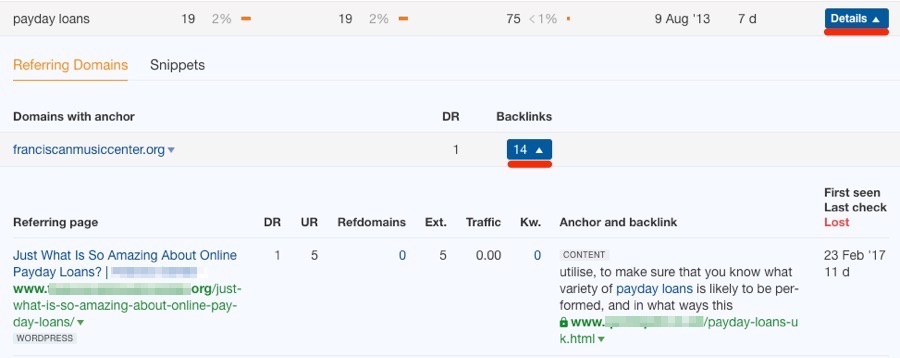
 Here are some rough guidelines for dealing with different types of links you find here:
Here are some rough guidelines for dealing with different types of links you find here:
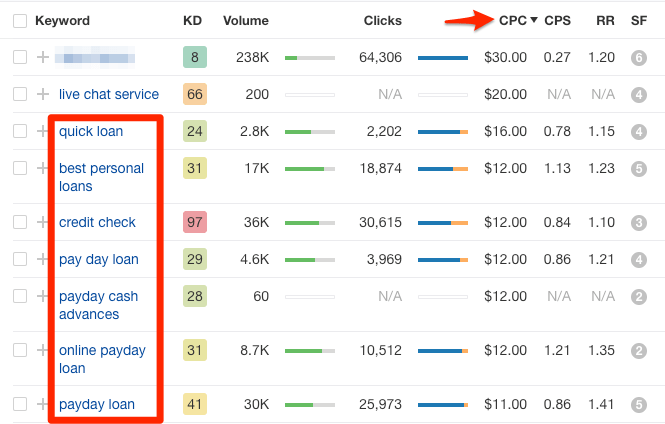
 Because high CPC anchors are often more likely to be the spammy ones, this should result in spammy anchors rising to the top of the list.
Finally, search for any spammy‐looking anchors in the Anchors report in Site Explorer and investigate further.
Because high CPC anchors are often more likely to be the spammy ones, this should result in spammy anchors rising to the top of the list.
Finally, search for any spammy‐looking anchors in the Anchors report in Site Explorer and investigate further.



 Reach out and ask for any such links to be nofollowed.
Reach out and ask for any such links to be nofollowed.
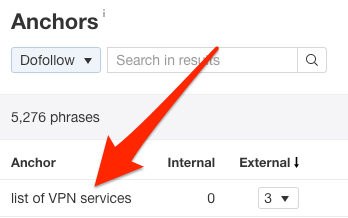
 Look for suspicious words and phrases that you wouldn’t expect to see on your site, and remove or nofollow any that appear manipulative (e.g., keyword‐rich anchors in guest post bios, etc.).
As for why this is important, Google explains this best:
Look for suspicious words and phrases that you wouldn’t expect to see on your site, and remove or nofollow any that appear manipulative (e.g., keyword‐rich anchors in guest post bios, etc.).
As for why this is important, Google explains this best:
If you can’t or don’t want to vouch for the content of pages you link to from your site — for example, untrusted user comments or guestbook entries — you should nofollow those links. This can discourage spammers from targeting your site, and will help keep your site from inadvertently passing PageRank to bad neighborhoods on the web.
site:yourwebsite.com "sponsored post"

 Open up any results one by one and locate the sponsored link.
If you installed the nofollow Chrome extension, all nofollow links on the page will be highlighted—so the sponsored link should definitely be highlighted. If it isn’t, it’s a followed link.
Open up any results one by one and locate the sponsored link.
If you installed the nofollow Chrome extension, all nofollow links on the page will be highlighted—so the sponsored link should definitely be highlighted. If it isn’t, it’s a followed link.
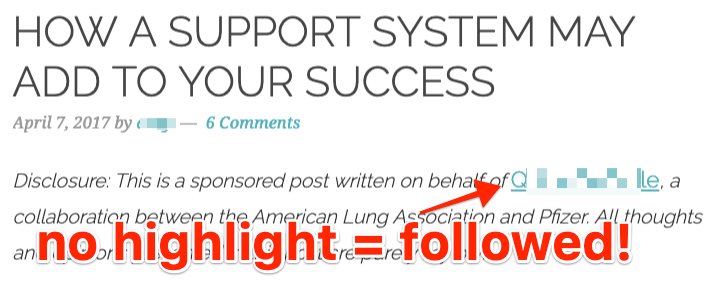
 Confirm this is the case by digging into the HTML.
Right‐click on the link, hit “Inspect,” and look for the rel=”nofollow” tag.
Confirm this is the case by digging into the HTML.
Right‐click on the link, hit “Inspect,” and look for the rel=”nofollow” tag.

 If it’s absent, then it’s a followed link and you should add a nofollow tag.
If it’s absent, then it’s a followed link and you should add a nofollow tag.
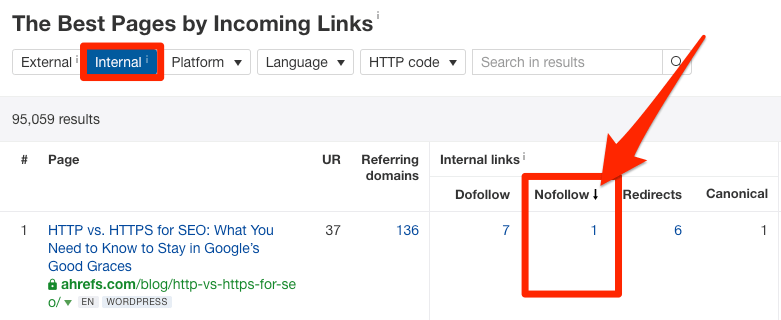
 If you see any pages with nofollowed internal links, hit the number to see where those links come from and investigate further. It may be the case that these make total sense (e.g., nofollowed internal links to a login page).
However, if there’s no obvious reason for the links to be nofollowed, remove the nofollow tag.
That’s the case here. For some reason, we have a nofollowed link from one blog post to another.
If you see any pages with nofollowed internal links, hit the number to see where those links come from and investigate further. It may be the case that these make total sense (e.g., nofollowed internal links to a login page).
However, if there’s no obvious reason for the links to be nofollowed, remove the nofollow tag.
That’s the case here. For some reason, we have a nofollowed link from one blog post to another.


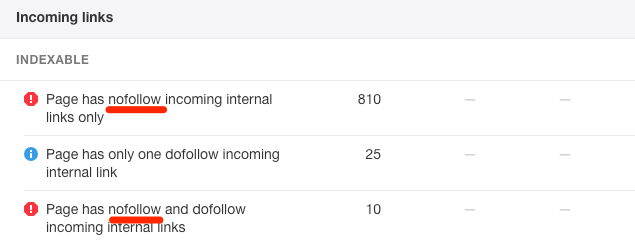
 Example of issues related to nofollow internal links in Ahrefs Site Audit
Learn how to set up your first crawl in Site Audit in this video:
Example of issues related to nofollow internal links in Ahrefs Site Audit
Learn how to set up your first crawl in Site Audit in this video:

 That makes it easy to prioritize when you’re analyzing competitors’ backlink profiles for replicable links, or building a list of “skyscraper” prospects, or whatever the case may be.
Do you still have questions? Hit me up in the comments below or via Twitter.
That makes it easy to prioritize when you’re analyzing competitors’ backlink profiles for replicable links, or building a list of “skyscraper” prospects, or whatever the case may be.
Do you still have questions? Hit me up in the comments below or via Twitter.
https://www.businesscreatorplus.com/nofollow-vs-follow-links-everything-you-need-to-know/